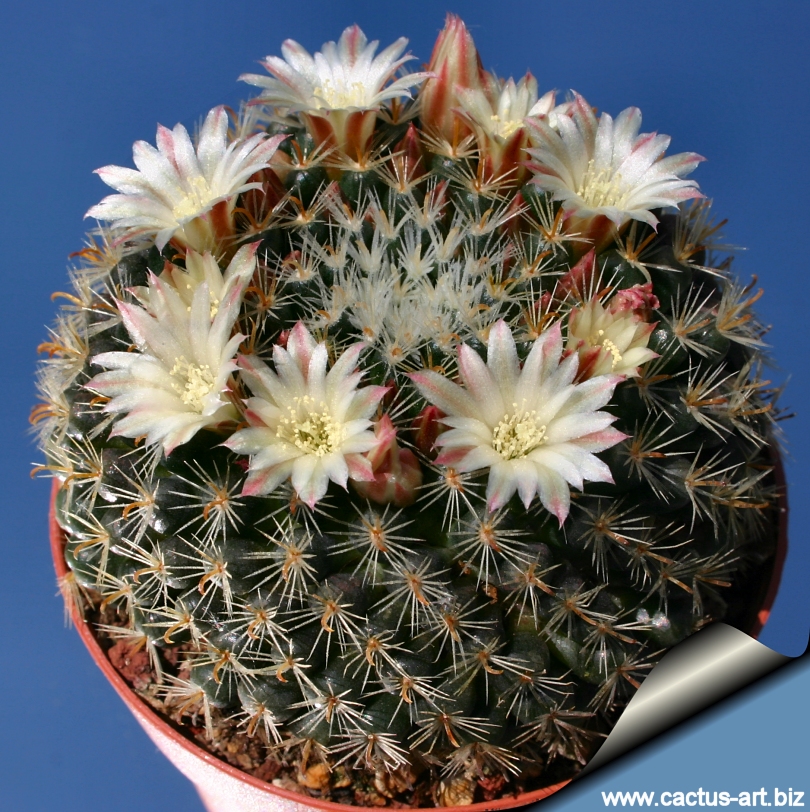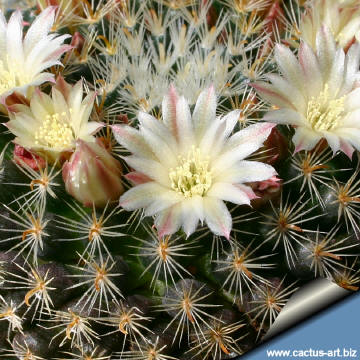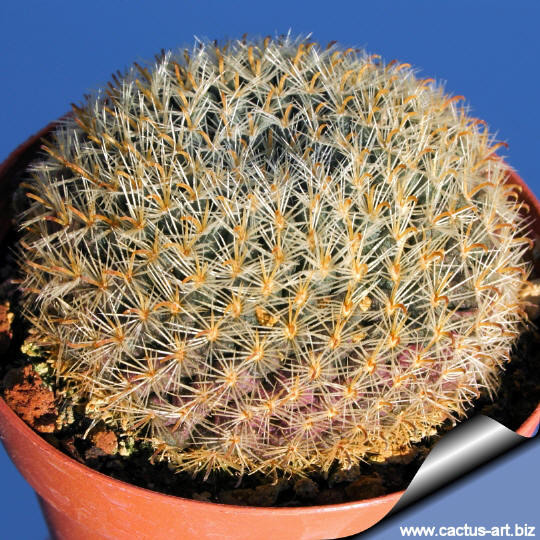|
|
|

Mammiallaria nana 'trichacantha'
SB21 North of SLP, SLP, Mexico.
It is also one of the most prolific bloomers among the Mammillarias.
|
|
Description: M.
trichacantha is a solitary or slowly clumping
globular cactus that eventually forms tiny mounds.
Stem: 1.5 to 4 cm high, 2.5 to 5 cm wide, soft, globular
depressed to shortly cylindrical. The
tubercles are small, clavate 4-5 mm high, slightly glaucous, the axil is
sparsely woolly, with bristles to 15 mm.
Radial spine: 15 - 18, about 7 mm long, acicular, thin, white,
pubescent partially interlacing,.
Central spine: At first none, later developing 1 or 2, tawny
brownish (sometime yellow/orangish), pubescent, the lower hooked, 7 - 9
mm long, the upper erect, to 4 mm.
Flower: Pale cream, pale yellow or white with pinkish brown
midstripe, 10 - 20 mm long, 10 - 15 mm in diameter. Inner segments
lanceolate, widely spreading, accuminate, stiyle green, stigma lobes
white.
Blooming season: Flowers readily, and for a
long period during the early summer.
Fruit: Red, elongated.
Seed: Brownish black.
|
|

The blooms are whitish yellow and up to 15 mm
long (occasionally with pink
midstrips).
|

This is a remarkable species on account of its having hairy brown to
yellow/orangish spines that finally turn to gray. |
|
Advertising
|
|
|
|
|
Family:
Cactaceae (Cactus
Family)
Mammillaria trichacantha Shuman
In: Gesamatb, Kakteen Nachtr.133. 1903
Accepted
Scientific name: Mammillaria
nana ssp nana
First description by
Backeberg, descr. Cact. Nov. 3: 8 (1963)
Origin: San Luis Potosi, Guanajuaro, Queretaro, (and
Hidalgo?) Mexico. Altitude 1.600 - 2.300 m.
Conservation status: Listed in
CITES appendix 2.
Other
Synonyms:
- Neomammillaria trichacantha
(Schum.) Britton et Rose
- Mammillaria
monancistracantha
Comments: Some authors
considered it as synonym of M. crinita.
 |
|
|
|
Cultivation: Needs
regular water in summer, but for best
appearance keep water off of the spines. Do
not let the soil become too dry in winter,
either. It does better with a good drained soil mix since it is a rot
prone species, whose
roots are easily lost in pots that stay damp for any length of time.
It takes a couple of years to offset, but once it starts it can fill a
25cm pot in just a few years. Propagation: Seeds, offsets (Cuttings root
quickly). Needs
full sun or light shade in summer.
Pests &
diseases: M.
triachantha is especially
prone to rot, therefore,
under-pot in a
smaller container filled with very
porous compost.
Propagation: Seeds or
graft. Seeds can be sown in the spring or summer. The seedlings
should not be disturbed until they are well rooted, after which
they can be planted separately in small pots.
Photo of conspecific taxa, varieties, forms and
cultivars of plants belonging to the Mammillaria crinita
complex
(This taxon has lots of synonyms
(like most mammillaria) with several
controversial varieties and subspecies):


|
|